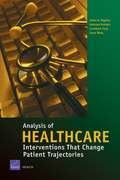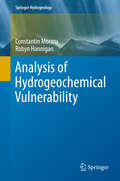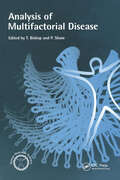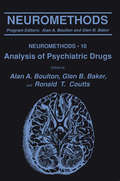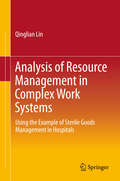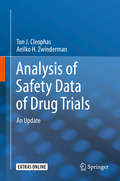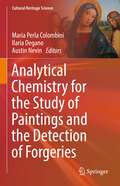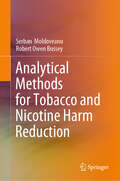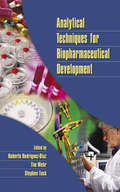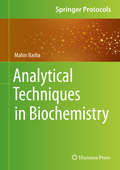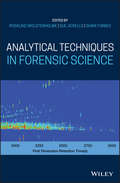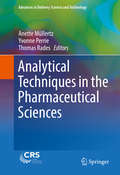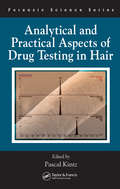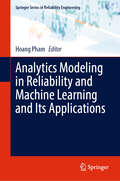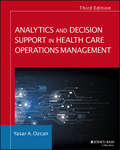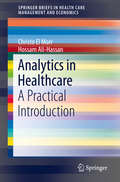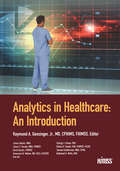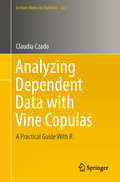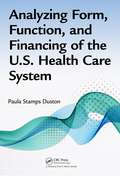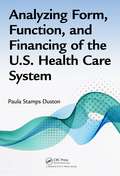- Table View
- List View
Analysis of Healthcare Interventions that Change Patient Trajectories
by Katya Fonkych James H. Bigelow Constance Fung Jason WangExamines interventions in the healthcare system that use Electronic Medical Record Systems (EMR-S) to affect patient trajectories--i.e., the sequence of encounters a patient has with the healthcare system--by improving health and thereby reducing healthcare utilization, or by reducing a costly form of utilization (e.g., inpatient stays) and increasing a more economical form (e.g., office visits to physicians, or prescription medications).
Analysis of Hydrogeochemical Vulnerability (Springer Hydrogeology)
by Robyn Hannigan Constantin MoraruThis monograph instructs the reader on how to analyze the hydrogeochemical vulnerability. It introduces notions of geochemical signals, points of migration of pollutants in the unsaturated zone, and new hydrogeochemical classifications. Three test sites in the USA, Germany, and Moldova are described as case studies accompanied by illustrative data. The authors presuppose for future readers only the background mathematics and elementary knowledge of hydrogeology. The presented methodology is both for local and regional assessments. It is simple, does not need implication of high qualification specialists and can be applied to test the groundwater quality. The book is useful for undergraduate, graduate, master, and PhD students as well as water quality specialists, ecologists and geology professionals.
Analysis of Multifactorial Diseases
by T. Bishop P. ShamAnalysis of Multifactorial Diseases examines the evidence of genetic factors that increase susceptibility to a range of complex diseases and describes the approaches taken to identify these genes. It reviews the successes and failures and examines whether there are any general conclusions to be drawn from this current range of approaches.
Analysis of Psychiatric Drugs (Neuromethods #10)
by Alan A. Boulton Glen B. Baker Ronald T. CouttsPlaces special emphasis on three major drug classes: antidepressants, antipsychotics, and anxiolytics. Chapters offer detailed information on the methods and techniques for analyzing these drugs. Annotation(c) 2003 Book News, Inc. , Portland, OR (booknews. com)
Analysis of Resource Management in Complex Work Systems: Using the Example of Sterile Goods Management in Hospitals
by Qinglian LinThis book develops and assesses a decision-making model for resource management in complex work systems in line with the Systems Engineering method. It applies the Balanced Scorecard to the development of the criteria system for decision-making, and employs fuzzy linguistics theory to evaluate the alternatives. Further, the book assesses the application of this model in a hospital that has to decide whether or not to outsource its sterile goods. The use of the model opens up a diverse range of fields for decision-making in the area of complex work systems. "
Analysis of Safety Data of Drug Trials: An Update
by Aeilko H. Zwinderman Ton J. CleophasIn 2010, the 5th edition of the textbook, "Statistics Applied to Clinical Studies", was published by Springer and since then has been widely distributed. The primary object of clinical trials of new drugs is to demonstrate efficacy rather than safety. However, a trial in humans which does not adequately address safety is unethical, while the assessment of safety variables is an important element of the trial.An effective approach is to present summaries of the prevalence of adverse effects and their 95% confidence intervals. In order to estimate the probability that the differences between treatment and control group occurred merely by chance, a statistical test can be performed. In the past few years, this pretty crude method has been supplemented and sometimes, replaced with more sophisticated and better sensitive methodologies, based on machine learning clusters and networks, and multivariate analyses. As a result, it is time that an updated version of safety data analysis was published. The issue of dependency also needs to be addressed. Adverse effects may be either dependent or independent of the main outcome. For example, an adverse effect of alpha blockers is dizziness and this occurs independently of the main outcome "alleviation of Raynaud 's phenomenon". In contrast, the adverse effect "increased calorie intake" occurs with "increased exercise", and this adverse effect is very dependent on the main outcome "weight loss". Random heterogeneities, outliers, confounders, interaction factors are common in clinical trials, and all of them can be considered as kinds of adverse effects of the dependent type. Random regressions and analyses of variance, high dimensional clusterings, partial correlations, structural equations models, Bayesian methods are helpful for their analysis. The current edition was written for non-mathematicians, particularly medical and health professionals and students. It provides examples of modern analytic methods so far largely unused in safety analysis. All of the 14 chapters have two core characteristics, First, they are intended for current usage, and they are particularly concerned with that usage. Second, they try and tell what readers need to know in order to understand and apply the methods. For that purpose, step by step analyses of both hypothesized and real data examples are provided.
Analysis of a Model for Epilepsy: Application of a Max-Type Difference Equation to Mesial Temporal Lobe Epilepsy (Chapman & Hall/CRC Monographs and Research Notes in Mathematics)
by Candace M. Kent David M. ChanIn the 1960s and 1970s, mathematical biologists Sir Robert M. May, E.C. Pielou, and others utilized difference equations as models of ecological and epidemiological phenomena. Since then, with or without applications, the mathematics of difference equations has evolved into a field unto itself. Difference equations with the maximum (or the minimum or the "rank-type") function were rigorously investigated from the mid-1990s into the 2000s, without any applications in mind. These equations often involved arguments varying from reciprocal terms with parameters in the numerators to other special functions. Recently, the authors of Analysis of a Model for Epilepsy: Application of a Max-Type Difference Equation to Mesial Temporal Lobe Epilepsy and their colleagues investigated the first known application of a "max-type" difference equation. Their equation is a phenomenological model of epileptic seizures. In this book, the authors expand on that research and present a more comprehensive development of mathematical, numerical, and biological results. Additionally, they describe the first documented instance of a novel dynamical behavior that they call rippled almost periodic behavior, which can be described as an unpredictable pseudo-periodic behavior. Features: Suitable for researchers in mathematical neuroscience and potentially as supplementary reading for postgraduate students Thoroughly researched and replete with references
Analytical Chemistry for the Study of Paintings and the Detection of Forgeries (Cultural Heritage Science)
by Austin Nevin Maria Perla Colombini Ilaria DeganoForgeries present a daunting problem to art historians, museums, galleries and curators who face challenges in determining the authenticity of paintings. Recent progress in science has led to the development of new methods for investigating works of art, and can provide new insights into the materials found in paintings. The rise in the value of paintings together with the knowledge and skills of forgers highlights the need to develop reliable scientific procedures to identify fakes. Given the complexity of materials in paintings and the convergence of various disciplines, a methodological approach for nvestigations of paintings is based on art historical, curatorial, aesthetic, technical and scientific evaluation. In this book sophisticated digital and analytical techniques are reviewed for the identification of materials (pigments, binders, varnishes, adhesives) and the physical characteristics of paintings such as brushstrokes, craquelure and canvas weaves. This book presents an updated overview of both non-invasive and micro-invasive techniques that enable the material characterization of paintings. The materials constituting a painting are reviewed, as are ways that changes in materials over time can provide insights into chronology and physical history. State-of the art digital metods including multi and hyper-spectral imaging and computational approaches to data treatment will be presented. Analytical techniques developed and optimized to characterize binders, varnishes, and pigments are reviewed, focusing on materials which can provide information on ageing or provenance. Case studies of applications of synchrotron-based methods and the analysis of paintings are given, as are chapters devoted to legal aspects related to authenticity. Chapter 1 is available open access under a Creative Commons Attribution 4.0 International License via link.springer.com.
Analytical Methods for Tobacco and Nicotine Harm Reduction
by Serban Moldoveanu Robert Owen BusseyThis book presents a critical review of the analytical methods used for the measurement of harmful and potentially harmful compounds (HPHC) in tobacco and nicotine-related products. In the first chapter of the book, a presentation of the main types of tobacco products is introduced, including cigarettes, cigars, cigarillos, little filter cigars, dissolvable tobacco products, hookah (shisha or waterpipe), nicotine gels, pipe tobacco products, roll your own, smokeless tobacco products, such as dip, snuff, snus, and chewing tobacco and E-Cigarettes, vapes, and other electronic nicotine delivery systems (ENDS). In the second and main part of the book, the analytical methods for the compounds in the established list from the U.S. Food and Drug Administration (FDA) of HPHC are discussed. For example, in cigarette smoke, specific discussions related to the analytical methods for nicotine, acetaldehyde, acrolein, acrylonitrile, aromatic amines, ammonia, benzene, benzo[a]pyrene, 1,3-butadiene, carbon monoxide, crotonaldehyde, formaldehyde, isoprene, TSNA&’s, and toluene are presented. Specific analytical methods for the analysis of HPHC in ENDS are also included. Various other analytical methods used for all the 93 HPHC in the established list by FDA for tobacco products and tobacco smoke are presented. The book will be useful to scientists working in the industry as well as students and researchers interested in the area.
Analytical Philosophy of Medicine: Scientific Philosophy and Philosophy of Medicine (Philosophy and Medicine #151)
by Lucien KarhausenThis book describes the philosophy of medicine as a subset of the philosophy of science. It is grounded in an epistemological bottom-up account that arises from the clinical situation, the epidemiologic and the resulting public health account. The volume offers a set of coherent beliefs that are deductively closed, which means that any statement which is logically entailed by the theory belongs to the theory. Medicine does not originate, as usually admitted, with the notion of disease inasmuch as concepts of disease, malfunction or health are evolved, sophisticated and advanced constructs. Medical norms, i.e., pathological features, are logically and conceptually prior to normal features. Following Ludwig Wittgenstein, by analogy with the way members of a family resemble each other, diseases are often what Ludwig Wittgenstein called “family-resemblance concepts”, which manifest a similarity shared by things classified into certain groups in the way members of a family resemble each other: each shares characteristics which many but not all the others, and there are no necessary or sufficient conditions for belonging in that classification. This book analyses the confusions associated with the concept of health, and subsequently turns to medical interventions, preventive, therapeutic and palliative as well as to the caring relationship, patients’ autonomy, doctors’ authority, and paternalism. Finally, the epistemic, ethical, or ontological limits of medicine, are being discussed, and the final account leaves us at the end of the scale with the perspective afforded by the patient facing suffering, impairment, death and tragedy, not to mention the physician’s predicament, which give rise to the principle that undergirds them all, i.e., the value of life.
Analytical Similarity Assessment in Biosimilar Product Development
by Shein-Chung ChowThis book focuses on analytical similarity assessment in biosimilar product development following the FDA’s recommended stepwise approach for obtaining totality-of-the-evidence for approval of biosimilar products. It covers concepts such as the tiered approach for assessment of similarity of critical quality attributes in the manufacturing process of biosimilar products, models/methods like the statistical model for classification of critical quality attributes, equivalence tests for critical quality attributes in Tier 1 and the corresponding sample size requirements, current issues, and recent developments in analytical similarity assessment.
Analytical Techniques for Biopharmaceutical Development
by Stephen Tuck Tim Wehr Roberto Rodriquez-DiazThis reference assists scientists in the selection and application of analytical techniques for biopharmaceutical identification, formulation, and assessment-providing a valuable survey of exploratory methods commonly utilized during the preclinical, clinical, and commercial phases of development.
Analytical Techniques in Biochemistry (Springer Protocols Handbooks)
by Mahin BashaThis book provides a comprehensive overview of the major biochemical analytical techniques, with detailed descriptions of the instrumentation and applications. The contributions, which each focus on a specific technique, are based on a thorough review and analysis of the current literature as well as the authors’ experiences in the lab. Divided into nine parts, the book provides insights into basic separation techniques like sedimentation, filtration and centrifugation, as well as analytical techniques such as spectrophotometry, chromatography, electrophoresis, immuno-techniques, radioactivity and microscopy.
Analytical Techniques in Forensic Science
by Rosalind WolstenholmeAn in-depth text that explores the interface between analytical chemistry and trace evidence Analytical Techniques in Forensic Science is a comprehensive guide written in accessible terms that examines the interface between analytical chemistry and trace evidence in forensic science. With contributions from noted experts on the topic, the text features a detailed introduction analysis in forensic science and then subsequent chapters explore the laboratory techniques grouped by shared operating principles. For each technique, the authors incorporate specific theory, application to forensic analytics, interpretation, forensic specific developments, and illustrative case studies. Forensic techniques covered include UV-Vis and vibrational spectroscopy, mass spectrometry and gas and liquid chromatography. The applications reviewed include evidence types such as fibers, paint, drugs and explosives. The authors highlight data collection, subsequent analysis, what information has been obtained and what this means in the context of a case. The text shows how analytical chemistry and trace evidence can problem solve the nature of much of forensic analysis. This important text: Puts the focus on trace evidence and analytical science Contains case studies that illustrate theory in practice Includes contributions from experts on the topics of instrumentation, theory, and case examples Explores novel and future applications for analytical techniques Written for undergraduate and graduate students in forensic chemistry and forensic practitioners and researchers, Analytical Techniques in Forensic Science offers a text that bridges the gap between introductory textbooks and professional level literature.
Analytical Techniques in the Pharmaceutical Sciences (Advances in Delivery Science and Technology)
by Yvonne Perrie Thomas Rades Anette MüllertzThe aim of this book is to present a range of analytical methods that can be used in formulation design and development and focus on how these systems can be applied to understand formulation components and the dosage form these build. To effectively design and exploit drug delivery systems, the underlying characteristic of a dosage form must be understood--from the characteristics of the individual formulation components, to how they act and interact within the formulation, and finally, to how this formulation responds in different biological environments. To achieve this, there is a wide range of analytical techniques that can be adopted to understand and elucidate the mechanics of drug delivery and drug formulation. Such methods include e. g. spectroscopic analysis, diffractometric analysis, thermal investigations, surface analytical techniques, particle size analysis, rheological techniques, methods to characterize drug stability and release, and biological analysis in appropriate cell and animal models. Whilst each of these methods can encompass a full research area in their own right, formulation scientists must be able to effectively apply these methods to the delivery system they are considering. The information in this book is designed to support researchers in their ability to fully characterize and analyze a range of delivery systems, using an appropriate selection of analytical techniques. Due to its consideration of regulatory approval, this book will also be suitable for industrial researchers both at early stage up to pre-clinical research.
Analytical and Practical Aspects of Drug Testing in Hair (International Forensic Science and Investigation)
by Pascal KintzWritten by well-known, international authors, this comprehensive reference provides practical coverage of the best hair drug testing techniques and examines the drugs themselves. The authors review all new developments, the validation of analytical procedures, and the interpretation of data. Some of the applications discussed include doping, drug-facilitated crime investigating, workplace testing, and the granting of drivers' licenses. The authors describe specific drugs, such as opiates, cocaine, and cannabis, and discuss the different testing methods of them. The book also covers postmortem toxicology, pitfalls created by passive exposure, and testing for metals, including inductively coupled plasma spectrometry (ICP-MS), hair multielemen
Analytics Modeling in Reliability and Machine Learning and Its Applications (Springer Series in Reliability Engineering)
by Hoang PhamThis book presents novel research and application chapters on topics in reliability, statistics, and machine learning. It has an emphasis on analytical models and techniques and practical applications in reliability engineering, data science, manufacturing, health care, and industry using machine learning, AI, optimization, and other computational methods. Today, billions of people are connected to each other through their mobile devices. Data is being collected and analysed more than ever before. The era of big data through machine learning algorithms, statistical inference, and reliability computing in almost all applications has resulted in a dramatic shift in the past two decades. Data analytics in business, finance, and industry is vital. It helps organizations and business to achieve better results and fact-based decision-making in all aspects of life. The book offers a broad picture of current research on the analytics modeling and techniques and its applications in industry. Topics include: l Reliability modeling and methods. l Software reliability engineering. l Maintenance modeling and policies. l Statistical feature selection. l Big data modeling. l Machine learning: models and algorithms. l Data-driven models and decision-making methods. l Applications and case studies in business, health care, and industrial systems. Postgraduates, researchers, professors, scientists, engineers, and practitioners in reliability engineering and management, machine learning engineering, data science, operations research, industrial and systems engineering, statistics, computer science and engineering, mechanical engineering, and business analytics will find in this book state-of-the-art analytics, modeling and methods in reliability and machine learning.
Analytics and Decision Support in Health Care Operations Management
by Yasar A. OzcanA compendium of health care quantitative techniques based in Excel Analytics and Decision Support in Health Care Operations is a comprehensive introductory guide to quantitative techniques, with practical Excel-based solutions for strategic health care management. This new third edition has been extensively updated to reflect the continuously evolving field, with new coverage of predictive analytics, geographical information systems, flow process improvement, lean management, six sigma, health provider productivity and benchmarking, project management, simulation, and more. Each chapter includes additional new exercises to illustrate everyday applications, and provides clear direction on data acquisition under a variety of hospital information systems. Instructor support includes updated Excel templates, PowerPoint slides, web based chapter end supplements, and data banks to facilitate classroom instruction, and working administrators will appreciate the depth and breadth of information with clear applicability to everyday situations. The ability to use analytics effectively is a critical skill for anyone involved in the study or practice of health services administration. This book provides a comprehensive set of methods spanning tactical, operational, and strategic decision making and analysis for both current and future health care administrators. Learn critical analytics and decision support techniques specific to health care administration Increase efficiency and effectiveness in problem-solving and decision support Locate appropriate data in different commonly-used hospital information systems Conduct analyses, simulations, productivity measurements, scheduling, and more From statistical techniques like multiple regression, decision-tree analysis, queuing and simulation, to field-specific applications including surgical suite scheduling, roster management, quality monitoring, and more, analytics play a central role in health care administration. Analytics and Decision Support in Health Care Operations provides essential guidance on these critical skills that every professional needs.
Analytics in Healthcare: A Practical Introduction (SpringerBriefs in Health Care Management and Economics)
by Christo El Morr Hossam Ali-HassanThis book offers a practical introduction to healthcare analytics that does not require a background in data science or statistics. It presents the basics of data, analytics and tools and includes multiple examples of their applications in the field. The book also identifies practical challenges that fuel the need for analytics in healthcare as well as the solutions to address these problems. In the healthcare field, professionals have access to vast amount of data in the form of staff records, electronic patient record, clinical findings, diagnosis, prescription drug, medical imaging procedure, mobile health, resources available, etc. Managing the data and analyzing it to properly understand it and use it to make well-informed decisions can be a challenge for managers and health care professionals. A new generation of applications, sometimes referred to as end-user analytics or self-serve analytics, are specifically designed for non-technical users such as managers and business professionals. The ability to use these increasingly accessible tools with the abundant data requires a basic understanding of the core concepts of data, analytics, and interpretation of outcomes. This book is a resource for such individuals to demystify and learn the basics of data management and analytics for healthcare, while also looking towards future directions in the field.
Analytics in Healthcare: An Introduction (HIMSS Book Series)
by Raymond A. GensingerThe editors of the HIMSS Books' best-seller Health: From Smartphones to Smart Systems have returned to deliver an expansive survey of the initiatives, innovators, and technologies driving the patient-centered mobile healthcare revolution. mHealth Innovation: Best Practices from the Mobile Frontier explores the promise of mHealth as a balance between emerging technologies and process innovations leading to improved outcomes-with the ultimate aim of creating a patient-centered and consumer-driven healthcare ecosystem. Examining the rapidly changing mobile healthcare environment from myriad perspectives, the book includes a comprehensive survey of the current-state ecosystem-app development, interoperability, security, standards, organizational and governmental policy, innovation, next-generation solutions, and mBusiness-and 20 results-driven, world-spanning case studies covering behavior change, patient engagement, patient-provider decision making, mobile gaming, mobile prescription therapy, home monitoring, mobile-to-mobile online delivery, access to care, app certification and quality evaluations, mixed media campaigns, and much more.
Analyzing Dependent Data with Vine Copulas: A Practical Guide With R (Lecture Notes in Statistics #222)
by Claudia CzadoThis textbook provides a step-by-step introduction to the class of vine copulas, their statistical inference and applications. It focuses on statistical estimation and selection methods for vine copulas in data applications. These flexible copula models can successfully accommodate any form of tail dependence and are vital to many applications in finance, insurance, hydrology, marketing, engineering, chemistry, aviation, climatology and health.The book explains the pair-copula construction principles underlying these statistical models and discusses how to perform model selection and inference. It also derives simulation algorithms and presents real-world examples to illustrate the methodological concepts. The book includes numerous exercises that facilitate and deepen readers’ understanding, and demonstrates how the R package VineCopula can be used to explore and build statistical dependence models from scratch. In closing, the book provides insights into recent developments and open research questions in vine copula based modeling.The book is intended for students as well as statisticians, data analysts and any other quantitatively oriented researchers who are new to the field of vine copulas. Accordingly, it provides the necessary background in multivariate statistics and copula theory for exploratory data tools, so that readers only need a basic grasp of statistics and probability.
Analyzing Form, Function, and Financing of the U.S. Health Care System
by Paula Stamps DustonAnalyzing Form, Function, and Financing of the U.S. Health Care System tells the story of the U.S. health care system by using a narrative approach identifying function rather than the more common data-driven focus on structure. It presents policy decisions we have made about our health care system and analyzes some of their consequences to better understand the choices we have. To facilitate this, the book is divided into four major sections. <p><p> Section I is mostly "about" the health care system. It describes several theoretical models that provide a foundation for the structure of the U.S. health care system. Section II provides a description of the form, or organization, of the U.S. health care delivery system. It presents a comprehensive overview of the entire health care delivery system, including identifying all levels of care. <p> Section III focuses on financing, beginning with a description of the economic and political values that determine how we finance our system. It describes health insurance, from the perspective of both the consumer and the provider, and discusses how money moves through the system. It concludes with a discussion and analysis of cost and cost control efforts. <p> Section IV describes some of the more important efforts in health care reform, including several targeted programs that are a significant part of the U.S. health care system, such as Medicare and Medicaid. It also describes other targeted programs within the U.S. health care system and explores how other countries with economies similar to that of the United States organize and finance their health care systems.
Analyzing Form, Function, and Financing of the U.S. Health Care System
by Paula Stamps DustonAnalyzing Form, Function, and Financing of the U.S. Health Care System tells the story of the U.S. health care system by using a narrative approach identifying function rather than the more common data-driven focus on structure. It presents policy decisions we have made about our health care system and analyzes some of their consequences to better
Analyzing Health Data in R for SAS Users
by Monika Maya Wahi Peter SeebachAnalyzing Health Data in R for SAS Users is aimed at helping health data analysts who use SAS accomplish some of the same tasks in R. It is targeted to public health students and professionals who have a background in biostatistics and SAS software, but are new to R. For professors, it is useful as a textbook for a descriptive or regression modeling class, as it uses a publicly-available dataset for examples, and provides exercises at the end of each chapter. For students and public health professionals, not only is it a gentle introduction to R, but it can serve as a guide to developing the results for a research report using R software. Features: Gives examples in both SAS and R Demonstrates descriptive statistics as well as linear and logistic regression Provides exercise questions and answers at the end of each chapter Uses examples from the publicly available dataset, Behavioral Risk Factor Surveillance System (BRFSS) 2014 data Guides the reader on producing a health analysis that could be published as a research report Gives an example of hypothesis-driven data analysis Provides examples of plots with a color insert
Analyzing Health Equity Using Household Survey Data: A Guide to Techniques and Their Implementation
by Owen O'Donnell Adam Wagstaff Magnus LindelowHave gaps in health outcomes between the poor and better off grown? Are they larger in one country than another? Are health sector subsidies more equally distributed in some countries than others? Are health care payments more progressive in one health care financing system than another? What are catastrophic payments and how can they be measured? How far do health care payments impoverish households? Answering questions such as these requires quantitative analysis. This in turn depends on a clear understanding of how to measure key variables in the analysis, such as health outcomes, health expenditures, need, and living standards. It also requires set quantitative methods for measuring inequality and inequity, progressivity, catastrophic expenditures, poverty impact, and so on. This book provides an overview of the key issues that arise in the measurement of health variables and living standards, outlines and explains essential tools and methods for distributional analysis, and, using worked examples, shows how these tools and methods can be applied in the health sector. The book seeks to provide the reader with both a solid grasp of the principles underpinning distributional analysis, while at the same time offering hands-on guidance on how to move from principles to practice.
